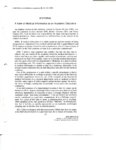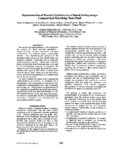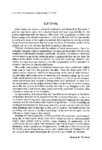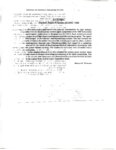1 - 25 of 19
| Creator | Title | Description | Subject | Date | ||
|---|---|---|---|---|---|---|
| 1 |
 |
Warner, Homer R. | A View of Medical Informatics as an Academic Disipline (Editorial) | Biomedical Informatics | 1993 | |
| 2 |
 |
Couldwell, William T. | Clinical and radiographic response in a minority of patients with recurrent malignant gliomas treated with high-dose tamoxifen | PREVIOUS WORK HAS demonstrated the importance of the Protein Kinase C (PKC) signal transduction system in regulating the growth rate of malignant gliomas in vitro. Tamoxifen inhibits PKC in a minority of malignant gliomas within the micromolar concentration range in vitro, a property distinct from... | Tamoxifen; Protein kinase C; Glioma; Brain neoplasm; Chemotherapy; Glioma | 1993 |
| 3 |
 |
Couldwell, William T. | Cosmetic mastoidectomy for the combined supra/infratentorial transtemporal approach | The authors describe a cosmetic mastoidectomy technique for use when performing a combined supra/ infratentorial craniotomy and transtemporal exposure. The technique involves a single temporal suboccipital bone flap and cosmetic mastoidectomy, removing the outer table of bone for later replacement... | Surgical approach; Supratentorial approach; Infratentorial approach; Petroclival meningiomas | 1993 |
| 4 |
 |
Caserta, Michael | Course of spousal bereavement in later life | The overall purpose of this chapter is to provide an overview of the major findings from our research over the past 11 years on spousal bereavement among older adults in the United States. We began in 1980 with a longitudinal study funded by the National Institute on Aging (NIA) designed to describ... | Senior citizens; Support groups; Death; Bereavement | 1993 |
| 5 |
 |
Gardner, Reed M. | Development of an Effective User Interface for a Computerized Laboratory Alerting System | Biomedical Informatics | 1993 | |
| 6 |
 |
Couldwell, William T. | Development of neurosurgery in Southern California and the Los Angeles County/University of Southern California Medical Center | The Los Angeles County General Hospital has played an integral role in the development of medicine and neurosurgery in Southern California. From its fledgling beginnings, the University of Southern California School of Medicine has been closely affiliated with the hospital, providing the predomina... | Historical vignette; Los Angeles County General Hospital; University of Southern California School of Medicine; Neurosurgical history | 1993 |
| 7 |
 |
Dailey, Andrew T. | Emergent aneurysm clipping without angiography in the moribund patient with intracerebral hemorrhage: the use of infusion computed tomography scans | THE AUTHORS REPORT their experience with 25 patients (mean age, 44.3 ± 12.1 years) with an intracerebral hematoma (ICH) from a ruptured aneurysm who were emergently operated on without angiography. Instead, preoperative high-resolution infusion computed tomography (CT) scans were used to identify... | Ruptured aneurysms; Computed tomography; Infusion computed tomography; Aneurysm clipping | 1993 |
| 8 |
 |
Warner, Homer R. | Implementation of Practice in a Clinical Setting Using a Computerized Knowledge Base (ILIAD) | Biomedical Informatics | 1993 | |
| 9 |
 |
Couldwell, William T. | Life-threatening reactions to propofol | To the Editor: Propofol (2,6-diisopropyl phenol; Diprivan; Stuart Pharmaceuticals, Wilmington, DE) has been advocated as a titratable continuous infusion anesthetic agent associated with fast and smooth recovery (2, 7). The anesthetic properties of a smooth induction, short half-life, and rapid eme... | Propofol; Diprivan | 1993 |
| 10 |
 |
Kestle, John R. W. | Moyamoya phenomenon after radiation for optic glioma | The role of radiotherapy in the management of patients with optic pathway glioma is controversial. In a series of patients with optic pathway glioma treated at The Hospital for Sick Children in Toronto, five children were encountered who developed moyamoya phenomenon after radiotherapy. A retrospec... | Optic pathway glioma | 1993 |
| 11 |
 |
Dailey, Andrew T. | Paragangliomas of the sellar region: report of two cases | TWO CASES OF paraganglioma arising from the parasellar region are presented. Both occurred in middle-aged women who sought treatment of headaches but who had no endocrinological dysfunction; one case was associated with ophthalmoplegia from cavernous sinus involvement. Diagnosis in both cases was ... | Paragangliomas; Sellar region; Parasellar region; Chemodectoma; Pituitary tumor | 1993 |
| 12 |
 |
Couldwell, William T. | Penetrating craniocerebral injury resultant from gunshot wounds: gang-related injury in children and adolescents | WE PROSPECTIVELY AND retrospectively reviewed a series of 780 patients who presented to the University of Southern California/Los Angeles County Medical Center with a diagnosis of gunshot wound to the brain during an 8-year period. Of these, 105 were children ranging in age from 6 months to 17 yea... | Craniocerebral injury; Los Angeles County General Hospital; University of Southern California School of Medicine | 1993 |
| 13 |
 |
Couldwell, William T. | Protein kinase C inhibitors suppress cell growth in established and low-passage glioma cell lines. a comparison between staurosporine and tamoxifen | WE HAVE PREVIOUSLY demonstrated that the proliferation of established human glioma cell lines correlated with protein kinase C (PKC) activity and that a relatively selective PKC inhibitor, staurosporine, inhibits glioma cell proliferation. The purpose of this study was to determine whether low-passa... | Staurosporin; Tamoxifen; Protein kinase C; Glioma; Brain neoplasm; Glioma cell lines | 1993 |
| 14 |
 |
Dailey, Andrew T. | Resolution of an actinomycotic abscess with nonsurgical treatment: case report | A CASE OF actinomycotic brain abscess is presented. Conservative treatment by prolonged administration of antibiotics after needle biopsy showed complete resolution of the abscess. Previously reported cases suggest that definitive treatment requires excision or open surgical drainage of the abscess... | Actinomycotic abscess; Brain abscess; Actinomyces israelii; Nonsurgical treatment | 1993 |
| 15 |
 |
Kriesel, John D.; Spruance, Spotswood L. | Rocky Mountain spotted fever following cardiac transplantation. | ROCKY MOUNTAIN SPOTTED FEVER was first recognized in the early 1 900s in the Snake River Valley of Idaho and the Bitterroot Valley of western Montana.t In 1909, Howard Taylor Ricketts established the ixodid tick as the vector for the disease.2 Following the tick bite, the incubation period aver... | Male; Adult; Humans | 1993 |
| 16 |
 |
Kestle, John R. W. | Role of angiography following aneurysm surgery | The postoperative angiograms in 66 patients who underwent craniotomy for clipping of 78 cerebral aneurysms were reviewed. Indications for urgent postoperative angiography included neurological deficit or repeat subarachnoid hemorrhage. Routine postoperative angiograms were carried out in the remai... | Postoperative angiography; Aneurysm rest; Cerebral angiography; Vascular occlusion | 1993 |
| 17 |
 |
Schmidt, Meic H. | Role of photodynamic therapy in posterior fossa brain tumors: a preclinical study in a canine glioma model | Photodynamic therapy was studied in dogs with and without posterior fossa glioblastomas. This mode of therapy consisted of intravenous administration of Photofrin-II at doses ranging from 0.75 to 4 mg/kg 24 hours prior to laser light irradiation in the posterior fossa. Tissue levels of Photofrin-l... | Brain neoplasm; Posterior fossa; Photodynamic therapy; Glioblastomas; Dog; Photofrin-II; Canine glioma model | 1993 |
| 18 |
 |
Warner, Homer R. | Stepping Down as Editor of Computers and Biomedical Research (Editorial) | Biomedical Informatics | 1993 | |
| 19 |
 |
Warner, Homer R. | Student Paper Finalists: SCAMC 1992 (Editorial) | Biomedical Informatics | 1993 |
1 - 25 of 19
